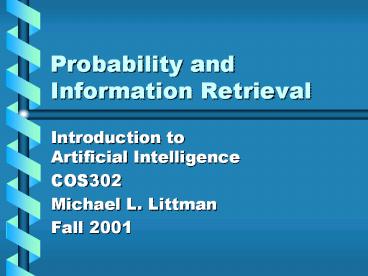Probability and Information Retrieval - PowerPoint PPT Presentation
1 / 31
Title:
Probability and Information Retrieval
Description:
Title: Heuristic Search Last modified by: AT&T Document presentation format: On-screen Show Other titles: Times New Roman Arial Black High Voltage Probability and ... – PowerPoint PPT presentation
Number of Views:248
Avg rating:3.0/5.0
Title: Probability and Information Retrieval
1
Probability and Information Retrieval
- Introduction toArtificial Intelligence
- COS302
- Michael L. Littman
- Fall 2001
2
Administration
- Foundations of Statistical Natural Language
Processing - By Christopher D. Manning and Hinrich Schutze
- Grade distributions online.
3
The IR Problem
- query
- doc1
- doc2
- doc3
- ...
- Sort docs in order of relevance to query.
4
Example Query
- Query The 1929 World Series
- 384,945,633 results in Alta Vista
- GNU's Not Unix! - the GNU Project and the Free
Software Foundation (FSF) - Yahoo! Singapore
- The USGenWeb Project - Home Page
5
Better List (Google)
- TSN Archives The 1929 World Series
- Baseball Almanac - World Series Menu
- 1929 World Series - PHA vs. CHC -
Baseball-Reference.com - World Series Winners (1903-1929) (Baseball World)
6
Goal
- Should return as many relevant docs as possible
- recall
- Should return as few irrelevant docs as
possible precision - Typically a tradeoff
7
Main Insights
- How identify good docs?
- More words in common is good.
- Rare words more important than common words.
- Long documents carry less weight, all other
things being equal.
8
Bag of Words Model
- Just pay attention to which words appear in
document and query. - Ignore order.
9
Boolean IR
- "and" all uncommon words
- Most web search engines.
- Altavista 79,628 hits
- fast
- not so accurate by itself
10
Example Biography
- Science and the Modern World (1925), a series of
lectures given in the United States, served as an
introduction to his later metaphysics. - Whitehead's most important book, Process and
Reality (1929), took this theory to a level of
even greater generality. - http//www-groups.dcs.st-and.ac.uk/history/Mathem
aticians/Whitehead.html
11
Vector-space Model
- For each word in common between document and
query, compute a weight. Sum the weights. - tf (term frequency) number of times term
appears in the document - idf (inverse document frequency) divide by
number of times term appears in any document - Also various forms of document-length
normalization.
12
Example Formula
- i sumj tfi,j dfi
- Insurance 10440 3997
- Try 10422 8760
- Weight(i,j) (1log(tfi,j)) log N/dfi
- Unless tfi,j 0 (then 0).
- N documents, dfi doc frequency
13
Cosine Normalization
- Cos(q,d) sumi qi di /
- sqrt(sumi qi2) sqrt(sumi di2)
- Downweights long documents.
- (Perhaps too much.)
14
Probabilistic Approach
- Lots of work studying different weighting
schemes. - Often very ad hoc, empirically motivated.
- Is there an analog of A for IR? Elegant,
simple, effective?
15
Language Models
- Probability theory is gaining popularity.
Originally speech recognition - If we can assign probabilities to sentence and
phonemes, we can choose the sentence that
minimizes the chance that were wrong
16
Probability Basics
- Pr(A) Probability A is true
- Pr(AB) Prob. both A B are true
- Pr(A) Prob. of not A 1-Pr(A)
- Pr(AB) Prob. of A given B
- Pr(AB)/Pr(B)
- Pr(AB) Probability A or B is true
- Pr(A) Pr(B) Pr(AB)
17
Venn Diagram
B
AB
A
18
Bayes Rule
- Pr(AB) Pr(BA) Pr(A) / Pr(B)
- because
- Pr(AB) Pr (B) Pr(AB) Pr(BA) Pr(A)
- The most basic form of learning
- picking a likely model given the data
- adjusting beliefs in light of new evidence
19
Probability Cheat Sheet
- Chain rule
- Pr(A,XY) Pr(AY) Pr(XA,Y)
- Summation rule
- Pr(XY) Pr(A X Y) Pr(A X Y)
- Bayes rule
- Pr(ABX) Pr(BAX) Pr(AX)/Pr(BX)
20
Speech Example
- Pr(sentencephonemes)
- Pr(phonemessentence) Pr(sentence) / Pr(phonemes)
21
Classification Example
- Given a song title, guess if its a country song
or a rap song. - U Got it Bad
- Cowboy Take Me Away
- Feelin on Yo Booty
- When God-Fearin' Women Get The Blues
- God Bless the USA
- Ballin out of Control
22
Probabilistic Classification
- Language model gives
- Pr(TR), Pr(TC), Pr(C), Pr(R)
- Compare
- Pr(RT) vs. Pr(CT)
- Pr(TR) Pr(R) / Pr(T) vs. Pr(TC) Pr(C) /
Pr(T) - Pr(TR) Pr(R) vs. Pr(TC) Pr(C)
23
Naïve Bayes
- Pr(TC)
- Generate words independently
- Pr(w1 w2 w3 wnC)
- Pr(w1C) Pr(w2C) Pr(wnC)
- So, Pr(partyR) 0.02, Pr(partyC) 0.001
24
Estimating Naïve Bayes
- Where would these numbers come from?
- Take a list of country song titles.
- First attempt
- Pr(wC) count(w C)
- / sumw count(w C)
25
Smoothing
- Problem Unseen words. Pr(partyC) 0
- Pr(Even Party Cowboys Get the Blues) 0
- Laplace Smoothing
- Pr(wC) (1count(w C))
- / sumw (1count(w C))
26
Other Applications
- Filtering
- Advisories
- Text classification
- Spam vs. important
- Web hierarchy
- Shakespeare vs. Jefferson
- French vs. English
27
IR Example
- Pr(dq) Pr(qd) Pr(d) / Pr(q)
Can view each document like a category for
classification.
28
Smoothing Matters
- p(wd)
- ps(wd) if count(wd)gt0 (seen)
- p(wcollection) if count(wd)0
- ps(wd) estimated from document and smoothed
- p(wcollection) estimated from corpus and
smoothed - Equivalent effect to TF-IDF.
29
What to Learn
- IR problem and TF-IDF.
- Unigram language models.
- Naïve Bayes and simple Bayesian classification.
- Need for smoothing.
30
Homework 6 (due 11/14)
- Use the web to find sentences to support the
analogy trafficstreetwaterriverbed. Give the
sentences and their sources. - Two common Boolean operators in IR are and and
or. (a) Which would you choose to improve
recall? (b) Which would you use to improve
precision?
31
Homework 6 (contd)
- 3. Argue that the language modeling approach to
IR gives an effect like TF-IDF. (a) First, argue
that Pr(qd) gt Pr(qd) if q is just like q but































